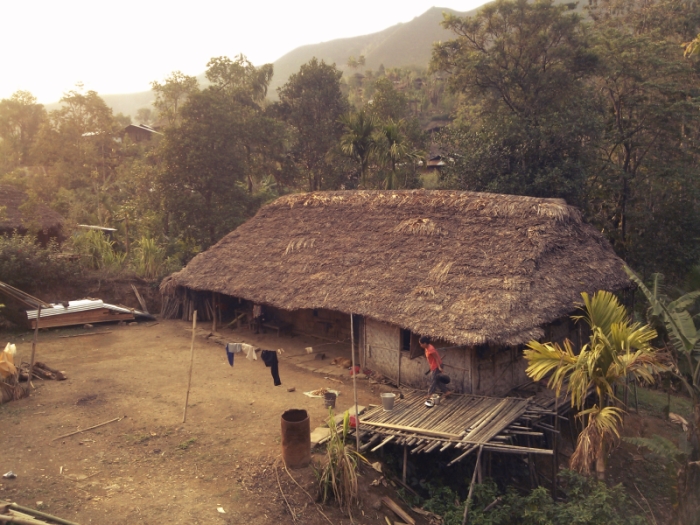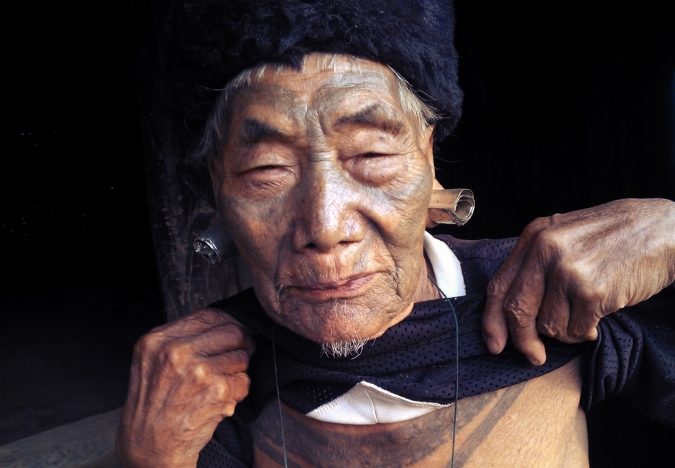
“The Konyak performs no rites or ceremonies till the sowing begins. He realizes that the cutting of the jungle and the proper clearing of the fields depends only on the efficiency of man. Why should he trouble the Gods? But when the seed is entrusted to the earth, where hundreds of dangers may threaten the crops, the Konyak turns to the Gods and solicits protection with offerings and prayers” writes Haimendorf in The Naked Nagas.
The word ‘Konyak’ is derived from ‘Kaonyak which means ‘blackhead’ or ‘human’. Situated in eastern Nagaland in northeastern India, the land of the Konyak is a mountainous region rich with forests and with temperate climate. The Konyaks like to live in mountain tops, maybe because of the hot days. There is no written record of their history and scholars depend mostly on myths and legends. The widespread belief is that the ancestors came from Longhong, hill of stones, or from Southeast Asia. Each village is ruled by a king, the Angh, who has ultimate authority. He can marry more than one woman, however only the queen’s son can be the heir to the kingship. There are three prominent features of a Konyak society. Headhunting; though nonexistent today, the custom of killing the enemy and bringing the head was considered a matter of courage and pride just a few decades back. The Konyaks believe the human skull to inhabit magical powers. Great anthologist Haimendorf in his book The Naked Nagas writes “The main importance of taking a head is not the glory of the war but the gain of the magical forces inherent in the skull”. Even today, one can still find a man wearing brass heads round his neck, signifying the heads he has taken in the past. Tattooing; the Konyaks use a kind of permanent dying to tattoo their face, chin or bosom. However, the Konyak youth today do not indulge in this practice. Morung; The word ‘Morung’ is Assamese in origin and it means ‘bachelor’s dormitories. With the attainment of a particular age, the boys and girls are sent to dormitories to be trained in discipline, warfare and customs. With the changing time, the importance of such institutes is losing ground but they still exist in a lesser extent. This makes it an urgency to make the youth feel pride in their heritage. With low impact tourism in the Konyak region, recent times has seen the youth gain employment and in turn feel pride about their indigenous past.

The most important festival among the Konyak is Aoling, which is celebrated in spring season with zest and gusto. The festival starts on 1st April and continues till the 6th April.
To end with, a quote from Haimendorf in order to emphasize the co-operative life of the Konyak people “A great house can be built in two or three days, for all clansmen and friends lend a hand, and are paid on completion by a lavish entertainment with much food and rice-beer… the Konyaks are born right -birds and they only begin really to wake up at midnight… to him the hours in the girls club are not wasted time and enjoyment is worth more than any material gain.”
This post is part of our series Celebrating Indigenous Peoples, focused on indigenous peoples of Northeast India and their times.

3 responses to “The Konyak People of Nagaland | Celebrating Indigenous Peoples”
Reblogged this on IFLA News Brief.
These are invaluable posts – documenting indigenous peoples’ customs and philosophies before they are gone.
Thanks Tish. Lets hope these cultures never disappear and their philosphies live long.